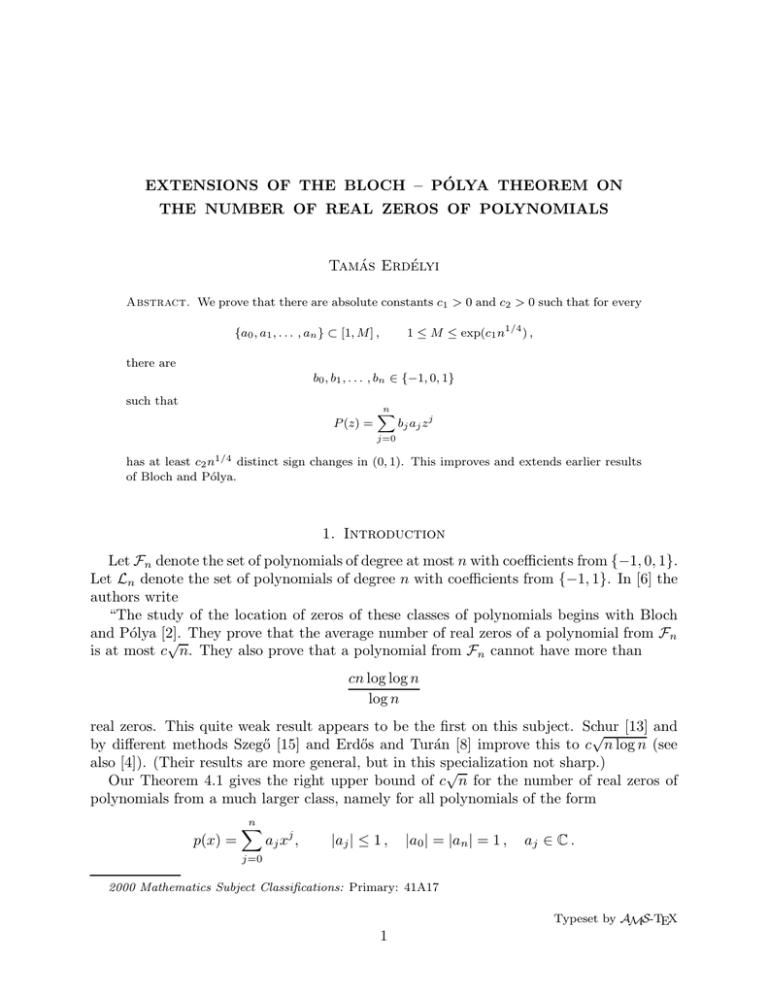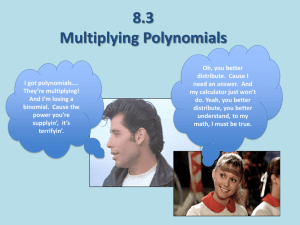EXTENSIONS OF THE BLOCH – P ´ OLYA THEOREM ON Tam´
advertisement

EXTENSIONS OF THE BLOCH – PÓLYA THEOREM ON
THE NUMBER OF REAL ZEROS OF POLYNOMIALS
Tamás Erdélyi
Abstract. We prove that there are absolute constants c1 > 0 and c2 > 0 such that for every
1 ≤ M ≤ exp(c1 n1/4 ) ,
{a0 , a1 , . . . , an } ⊂ [1, M] ,
there are
b0 , b1 , . . . , bn ∈ {−1, 0, 1}
such that
P (z) =
n
X
bj aj z j
j=0
has at least c2 n1/4 distinct sign changes in (0, 1). This improves and extends earlier results
of Bloch and Pólya.
1. Introduction
Let Fn denote the set of polynomials of degree at most n with coefficients from {−1, 0, 1}.
Let Ln denote the set of polynomials of degree n with coefficients from {−1, 1}. In [6] the
authors write
“The study of the location of zeros of these classes of polynomials begins with Bloch
and Pólya [2].
√ They prove that the average number of real zeros of a polynomial from Fn
is at most c n. They also prove that a polynomial from Fn cannot have more than
cn log log n
log n
real zeros. This quite weak result appears to be the first on this subject. Schur
√ [13] and
by different methods Szegő [15] and Erdős and Turán [8] improve this to c n log n (see
also [4]). (Their results are more general, but in this specialization
not sharp.)
√
Our Theorem 4.1 gives the right upper bound of c n for the number of real zeros of
polynomials from a much larger class, namely for all polynomials of the form
p(x) =
n
X
j=0
a j xj ,
|aj | ≤ 1 ,
|a0 | = |an | = 1 ,
aj ∈ C .
2000 Mathematics Subject Classifications: Primary: 41A17
Typeset by AMS-TEX
1
Schur [13] claims that Schmidt gives a version of part of this theorem. However, it does
not appear in the reference he gives, namely [12], and
√ we have not been able to trace it to
any other source. Also, our method is able to give c n as an upper bound for the number
of zeros of a polynomial p ∈ Pnc with |a0 | = 1, |aj | ≤ 1, inside any polygon with vertices
in the unit circle (of course, c depends on the polygon). This may be discussed in a later
publication.
Bloch and Pólya [2] also prove that there are polynomials p ∈ Fn with
cn1/4
√
log n
distinct real zeros of odd multiplicity. (Schur [13] claims they do it for polynomials with
coefficients only from {−1, 1}, but this appears to be incorrect.)
In a seminal paper Littlewood and Offord [11] prove that the number of real roots of a
p ∈ Ln , on average, lies between
c1 log n
and
c2 log2 n
log log log n
(1.1)
and it is proved by Boyd [7] that every p ∈ Ln has at most c log2 n/ log log n zeros at 1 (in
the sense of multiplicity).
Kac [10] shows that the expected number of real roots of a polynomial of degree n with
random uniformly distributed coefficients is asymptotically (2/π) log n. He writes “I have
also stated that the same conclusion holds if the coefficients assume only the values 1 and
−1 with equal probabilities. Upon closer examination it turns out that the proof I had
in mind is inapplicable.... This situation tends to emphasize the particular interest of the
discrete case, which surprisingly enough turns out to be
P then most difficult.” In a recent
related paper Solomyak [14] studies the random series
±λ .”
In fact, the paper [5] containing the “polygon result” mentioned in the above quote
appeared sooner than [6]. The book [4] contains only a few related weeker results. Our
Theorem 2.1 in [6] sharpens and generalizes results of Amoroso [1], Bombieri and Vaaler
[3], and Hua [9] who give versions of that result for polynomials with integer coefficients.
In this paper we improve the lower bound (1.1) in the result of Bloch and Pólya to
1/4
cn . Moreover we allow a much more general coefficient constraint in our main result.
Our approach is quite different from that of Bloch and Pólya.
2. New Result
Theorem 2.1. There are absolute constants c1 > 0 and c2 > 0 such that for every
there are
such that
{a0 , a1 , . . . , an } ⊂ [1, M ] ,
1 ≤ M ≤ exp(c1 n1/4 ) ,
b0 , b1 , . . . , bn ∈ {−1, 0, 1}
P (z) =
n
X
bj aj z j
j=0
has at least c2 n1/4 distinct sign changes in (0, 1).
2
3. Lemmas
Let D := {z ∈ C : |z| < 1} be the open unit disk. Denote by SM the collection of all
analytic functions f on the open unit disk D that satisfy
M
,
z ∈ D.
|f (z)| ≤
1 − |z|
Let kf kA := supx∈A |f (x)|. To prove Theorem 2.1 our first lemma is the following.
Lemma 3.1. There is an absolute constants c3 > 0 such that
−c3 (1 + log M )
kf k[α,β] ≥ exp
β−α
for every f ∈ SM and 0 < α < β ≤ 1 with |f (0)| ≥ 1 and for every M ≥ 1.
This follows from the lemma below by a linear scaling:
Lemma 3.2. There are absolute constants c4 > 0 and c5 > 0 such that
c4 (1 + log M )
c5/a
|f (0)|
≤ exp
kf k[1−a,1]
a
for every f ∈ SM and a ∈ (0, 1].
To prove Lemma 3.2 we need some corollaries of the following well known result.
Hadamard Three Circles Theorem. Let 0 < r1 < r2 . Suppose f is regular in
For r ∈ [r1 , r2 ], let
{z ∈ C : r1 ≤ |z| ≤ r2 } .
M (r) := max |f (z)| .
|z|=r
Then
M (r)log(r2 /r1 ) ≤ M (r1 )log(r2 /r) M (r2 )log(r/r1 ) .
Corollary 3.3. Let a ∈ (0, 1]. Suppose f is regular inside and on the ellipse Ea with foci
at 1 − a and 1 − a + 41 a and with major axis
9a
25a
.
1−a−
,1−a+
64
64
ea be the ellipse with foci at 1 − a and 1 − a + 1 a and with major axis
Let E
4
a
9a
.
1−a−
,1−a+
32
32
Then
!1/2 1/2
max |f (z)| ≤
max
|f (z)|
max |f (z)|
.
z∈Ea
ea
z∈[1−a,1−a+ 41 a]
z∈E
Proof. This follows from the Hadamard Three Circles Theorem with the substitution
a
a z + z −1
+ 1−a+
.
w=
8
2
8
The Hadamard Three Circles Theorem is applied with r1 := 1, r := 2, and r2 := 4. 3
Corollary 3.4. For every f ∈ SM and a ∈ (0, 1] we have
max |f (z)| ≤
ea
z∈E
64M
39a
1/2 1/2
max |f (z)|
.
z∈[1−a,1]
Proof of Lemma 3.2. Let f ∈ SM and h(z) = 21 (1 − a)(z + z 2 ). Observe that h(0) = 0,
and there are absolute constants c6 > 0 and c7 > 0 such that
|h(eit )| ≤ 1 − c6 t2 ,
−π ≤ t ≤ π ,
ea . Now let m := ⌊π/(c7 a)⌋ + 1. Let
and for t ∈ [−c7 a, c7 a], h(eit ) lies inside the ellipse E
ξ := exp(2πi/(2m)) be the first 2m-th root of unity, and let
g(z) =
2m−1
Y
f (h(ξ j z)) .
j=0
Using the Maximum Principle and the properties of h, we obtain
|f (0)|
2m
2 m−1
Y
M
= |g(0)| ≤ max |g(z)| ≤ max |f (z)|
ea
c6 (πk/m)2
|z|=1
z∈E
k=1
m−1 4
2
m
2m−2
= max |f (z)| M
exp(c8 (m − 1))
ea
(m − 1)!
z∈E
2
< max |f (z)| (M e)c9 (m−1)
2
ea
z∈E
with absolute constants c8 and c9 , and the result follows from Corollary 3.4. 4. Proof of Theorem 2.1
Proof of Theorem 2.1. Let L ≤ 21 n1/2 and
√
√
M(P ) := (P (1 − n−1/2 ), P (1 − 2n−1/2 ), . . . , P (1 − Ln−1/2 )) ∈ [−M n, M n]L .
We consider the polynomials
P (z) =
n−1
X
bj aj z j ,
j=0
bj ∈ {0, 1} .
There are 2n such polynomials. Let K ∈ N. Using the box principle we can easily deduce
that (2K)L < 2n implies that there are two different
P1 (z) =
n−1
X
bj aj z j ,
j=0
4
bj ∈ {0, 1} ,
and
P2 (z) =
n−1
X
j=0
such that
|P1 (1 − jn
−1/2
) − P2 (1 − jn
Let
P1 (z) − P2 (z) =
Let 0 6= Q(z) := z
−m
ebj aj z j ,
n−1
X
−1/2
ebj ∈ {0, 1} ,
√
M n
,
)| ≤
K
βj aj z j ,
j = 1, 2, . . . , L .
βj ∈ {−1, 0, 1},
j=m
(P1 (z) − P2 (z)). Then Q is of the form
Q(z) :=
n−1
X
γ j aj z j ,
j=0
γj ∈ {−1, 0, 1} ,
γ0 ∈ {−1, 1} ,
and, since 1 − x ≥ e−2x for all x ∈ [0, 1/2], we have
√
−1/2
1/2 M n
,
(4.1)
|Q(1 − jn
)| ≤ exp(2Ln )
K
Also, by Lemma 3.1, there are
such that
(4.2)
bm 6= 0 .
j = 1, 2, . . . , L .
ξj ∈ Ij := [1 − jn−1/2 , 1 − (j − 1)n−1/2 ] ,
√ |Q(ξj )| ≥ exp −c3 (1 + log M ) n ,
j = 1, 2, . . . , L ,
j = 1, 2, . . . , L .
Now let L := ⌊(1/16)n1/4 ⌋ and 2K = exp(n3/4 ). Then (2K)L < 2n holds. Also, if
log M = O(n1/4 ), then (4.1) implies
(4.3)
|Q(1 − jn−1/2 )| ≤ exp(−(3/4)n3/4 ) ,
j = 1, 2, . . . , L ,
for all sufficiently large n. Now observe that 1 ≤ M ≤ exp((64c3 )−1 n1/4 ) yields that
(4.4)
and
(4.5)
|an xn | ≥|x|n ≥ exp(−2(1 − x)) ≥ exp(−2Ln1/2 )
≥ exp(−(1/8)n3/4 ) ,
|an xn | ≤M exp(−(L/2)n1/2 )
≤ exp(−(1/33)n3/4 ) ,
x ∈ [1 − Ln−1/2 , 1 − (L/2)n−1/2 ] ,
x ∈ [1 − Ln−1/2 , 1 − (L/2)n−1/2 ] ,
for all sufficiently large n. Observe also that with log M ≤ (64c3 )−1 n1/4 (4.2) implies
(4.6)
|Q(ξj )| > exp(−(1/63)n3/4 ) ,
j = 1, 2, . . . , L ,
for all sufficiently large n. Now we study the polynomials
S1 (z) := Q(z) − an z n
and
S2 (z) := Q(z) + an z n .
These are of the requested special form. It follows from (4.3) – (4.6) that either S1 or S2
has a sign change in at least half of the intervals Ij , j = L, L − 1, . . . ⌊L/2⌋ + 2 , for all
sufficiently large n, and the theorem is proved. 5
References
1. F. Amoroso, Sur le diamètre transfini entier d’un intervalle réel, Ann. Inst. Fourier, Grenoble
40 (1990), 885–911.
2. A. Bloch and G. Pólya, On the roots of certain algebraic equations, Proc. London Math. Soc
33 (1932), 102–114.
3. E. Bombieri and J. Vaaler, Polynomials with low height and prescribed vanishing, in Analytic
Number Theory and Diophantine Problems, Birkhäuser (1987), 53–73.
4. P. Borwein and T. Erdélyi, Polynomials and Polynomial Inequalities, Springer-Verlag, New
York, 1995.
5. P. Borwein and T. Erdélyi, On the zeros of polynomials with restricted coefficients, Illinois J.
Math. 41 (1997), 667–675.
6. P. Borwein, T. Erdélyi, and G. Kós, Littlewood-type problems on [0, 1]., Proc. London Math.
Soc. 79 (1999), 22–46.
7. D. Boyd, On a problem of Byrnes concerning polynomials with restricted coefficients, Math.
Comput. 66 (1997), 1697–1703.
8. P. Erdős and P. Turán, On the distribution of roots of polynomials, Ann. Math. 57 (1950),
105–119.
9. L.K. Hua, Introduction to Number Theory, Springer-Verlag, Berlin Heidelberg, New York, 1982.
10. M. Kac, On the average number of real roots of a random algebraic equation, II, Proc. London
Math. Soc. 50 (1948), 390–408.
11. J.E. Littlewood and A.C. Offord, On the number of real roots of a random algebraic equation,
II, Proc. Cam. Phil. Soc. 35 (1939), 133-148.
12. E. Schmidt, Über algebraische Gleichungen vom Pólya-Bloch-Typos, Sitz. Preuss. Akad. Wiss.,
Phys.-Math. Kl. (1932), 321.
13. I. Schur, Untersuchungen über algebraische Gleichungen., Sitz. Preuss. Akad. Wiss., Phys.Math. Kl. (1933), 403–428.
P
14. B. Solomyak, On the random series
±λn (an Erdős problem), Ann. Math. 142, 611–625.
15. G. Szegő, Bemerkungen zu einem Satz von E. Schmidt über algebraische Gleichungen., Sitz.
Preuss. Akad. Wiss., Phys.-Math. Kl. (1934), 86–98.
Department of Mathematics, Texas A&M University, College Station, Texas 77843
E-mail address: terdelyi@math.tamu.edu
6







